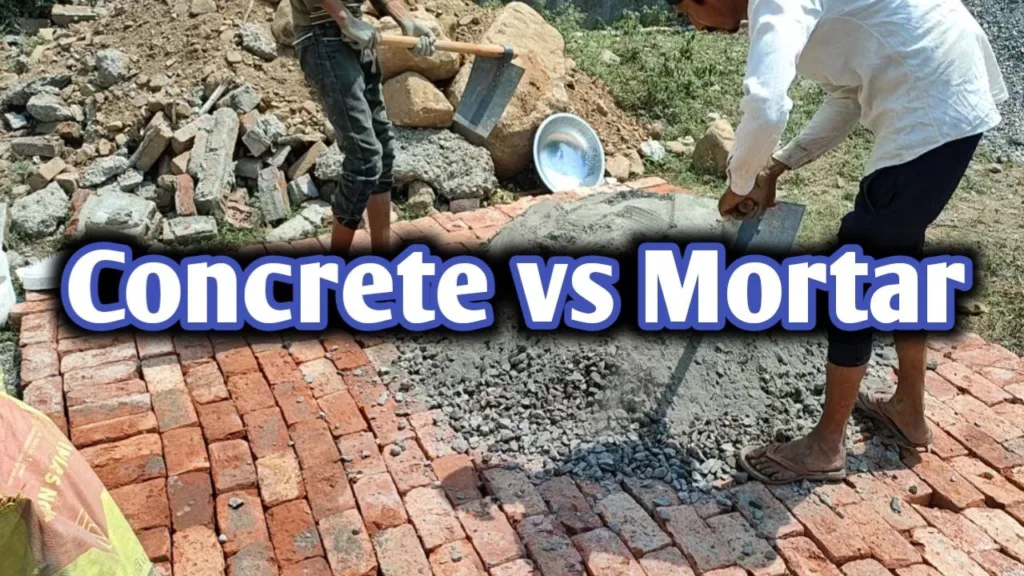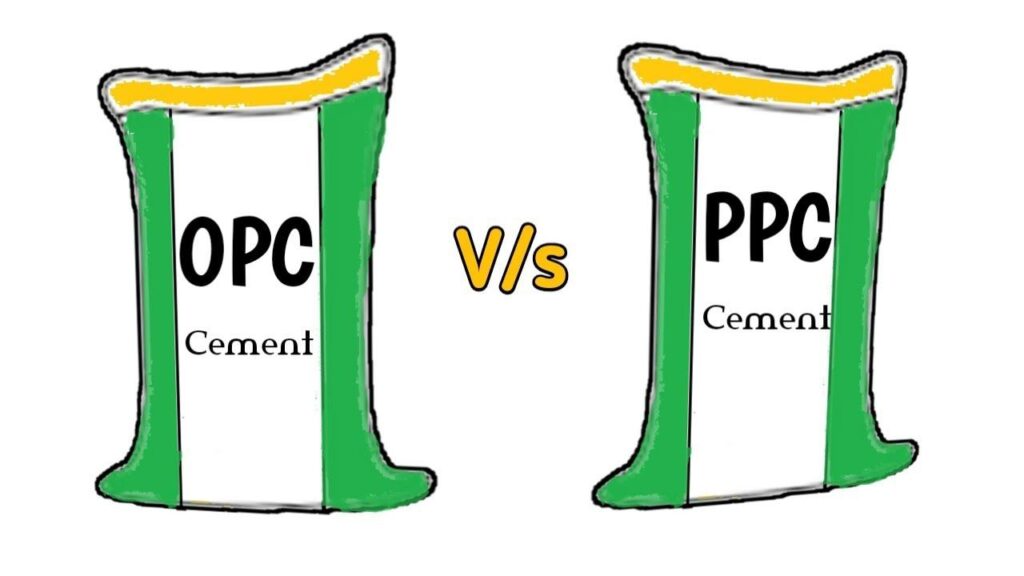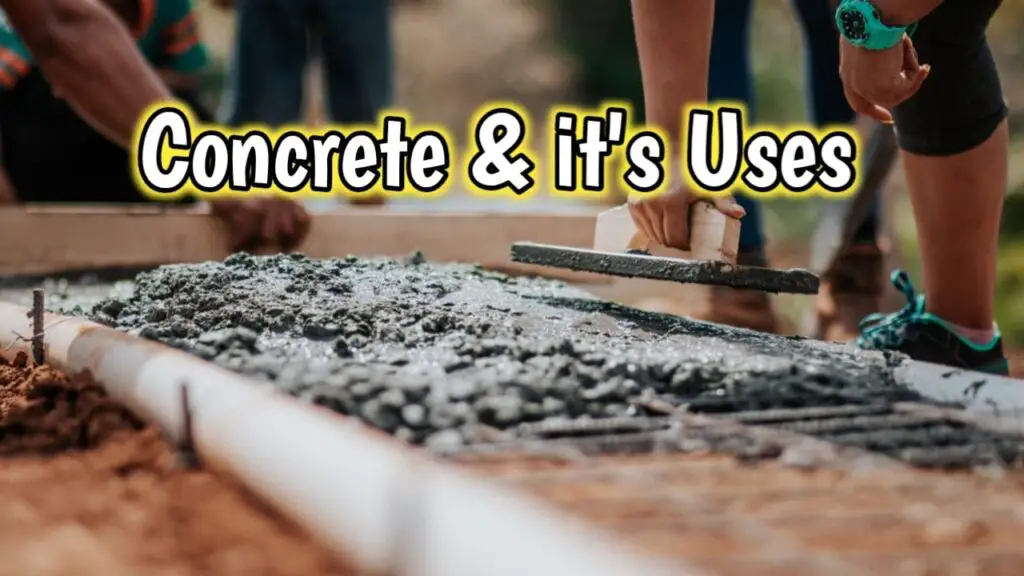Mortar vs Concrete
When it comes to construction, cement, mortar, concrete, and grout are all vital components that play significant roles in building structures that maintain their strength and integrity over time. However, many people often confuse these terms or use them interchangeably, potentially leading to confusion and errors during construction.
In this article, we will break down the key differences between cement, mortar, concrete, and grout. We will explore their characteristics, how they are made, and their specific applications in construction projects. By understanding these differences, you can make informed decisions about which material to use for your projects and achieve optimal results.
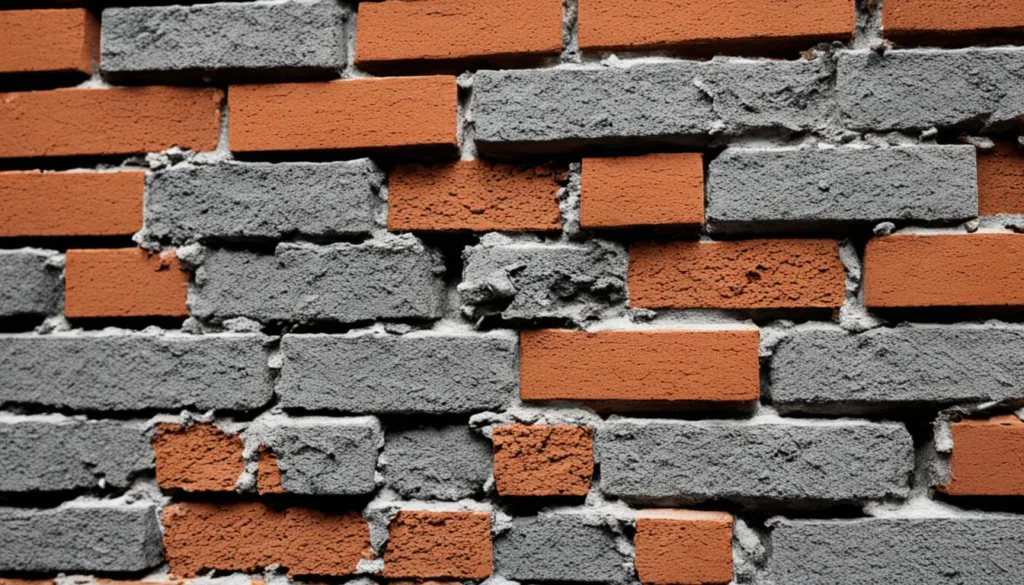

Key Takeaways:
- Cement, mortar, concrete, and grout are all essential components in construction projects.
- Knowing the differences between these materials is crucial to ensure successful construction.
- Cement is a binding agent used to strengthen and develop resistance in construction materials.
- Mortar is used to bind bricks and other materials together.
- Concrete is a mixture of water, aggregates, and cement. It is used extensively in construction projects for its durability and strength.
- Grout is a material used to fill gaps, joints, and cracks.
Understanding Cement
Cement is a crucial material in the construction industry. It is a binding substance that holds together various building components, such as sand, stone, brick, and aggregates. But what is cement exactly, and how is it made?
Cement is made primarily of two materials: limestone and clay. These materials are crushed and blended before being heated to extremely high temperatures in a kiln. This process, called calcination, results in a “clinker,” a porous material that is cooled and then ground into a fine powder.
The resulting powder is what we commonly refer to as cement. It can be blended with water to create a paste that hardens over time, forming a strong and durable bond between surfaces. However, it is important to note that cement is not the same as mortar, even though the two terms are often used interchangeably.
Fun Fact: The use of cement dates back to ancient civilizations, such as the Romans, who used a blend of volcanic ash and lime to construct their famous architectural wonders, such as the Colosseum and Pantheon.


Exploring Concrete
Concrete is a versatile construction material that’s used for everything from building foundations to highways and bridges. It’s made by combining cement, water, sand, and aggregates like gravel or crushed stone. Concrete has a high compressive strength, which makes it ideal for supporting heavy loads. It’s also resistant to fire and water damage and can be molded into various shapes and forms.
The production process of concrete involves mixing cement, aggregate, and water in specific proportions. The water reacts with the cement, causing it to harden and bind the aggregate together. The quality of concrete depends on the proper ratio of ingredients and the methods used for mixing and pouring.
While often confused with each other, there are distinct differences between mortar and concrete. Mortar is typically composed of cement, sand, and water and is used as a bonding material for bricks and tiles. Concrete, on the other hand, is a mixture that contains cement, sand, water, and aggregates, and is used as a structural material.
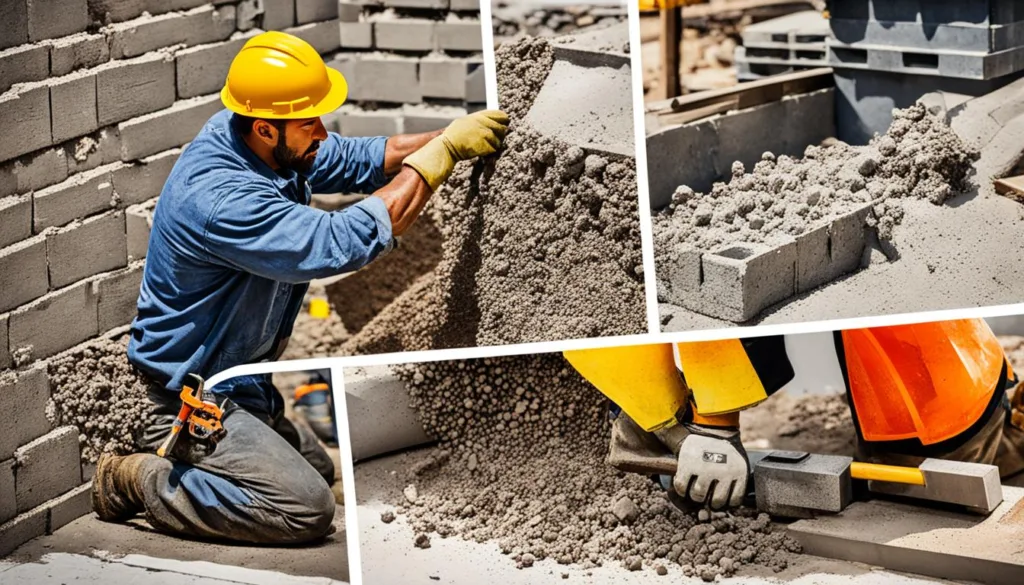

In general, concrete is more durable and stronger than mortar due to its composition and application. However, mortar is easier to work with in smaller construction projects and is more commonly used for decorative purposes such as adding finishing touches to masonry or creating textured surfaces.
Despite their differences, both concrete and mortar play critical roles in construction, and their choice depends on the project requirements and environmental factors.
Understanding Mortar
Mortar is a binding material used in construction to hold together bricks, stones, or other materials. It is made up of a combination of cement, sand, and water, and sometimes lime is included to improve the workability and strength of the mortar. How the mortar is made can have a significant impact on its final quality and effectiveness. The basic procedure for making mortar involves blending the dry mix of cement and sand and then gradually adding water until the desired consistency is achieved.
When it comes to mortar vs concrete, there are some key differences to be aware of. While both are used in construction, concrete typically contains larger aggregates, such as gravel, and is used for load-bearing projects. Mortar, on the other hand, is more finely ground and is used to bond materials together rather than support weight.
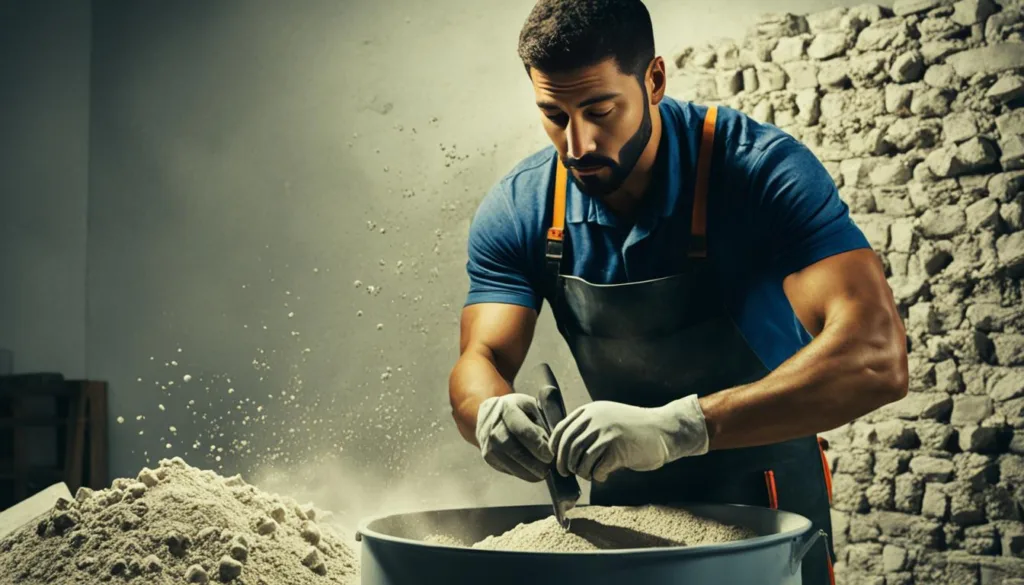

In addition to the standard mortar mix, there are various types of mortar available, each designed to suit specific construction projects. For example, there are mortar mixes that are ideal for laying bricks or blocks, while others are better for repointing. To ensure that the right type of mortar is chosen, it’s important to consider the needs of the project and consult with a professional if necessary.
Exploring Grout
Grout, similar to mortar, plays an essential role in masonry and is primarily used for filling gaps between tiles or stones to support their structure and prevent water infiltration. Grout is typically made up of cement, water, and sand, but it may also include additives to increase its strength or resistance to stains.
The manufacturing process for grout begins by mixing the dry ingredients in a bucket or tub. Water is gradually added, stirring well to create a smooth, consistent mixture. After the grout paste has formed, it is applied to the surface to be filled using a rubber float or trowel, lightly pressing it into the gaps. Any excess grout is then removed using a sponge or trowel.
When comparing mortar and grout, it is essential to note that while both have similar compositions, they serve different purposes. Mortar is primarily used to bond materials such as bricks or stones together and create a strong, load-bearing structure. Conversely, grout is designed to fill gaps between tiles or stones, primarily for aesthetic purposes, and to prevent moisture infiltration.
Comparing Mortar and Grout
To provide a better understanding of the differences between mortar and grout, the following table compares both materials based on their composition, application, and usage.
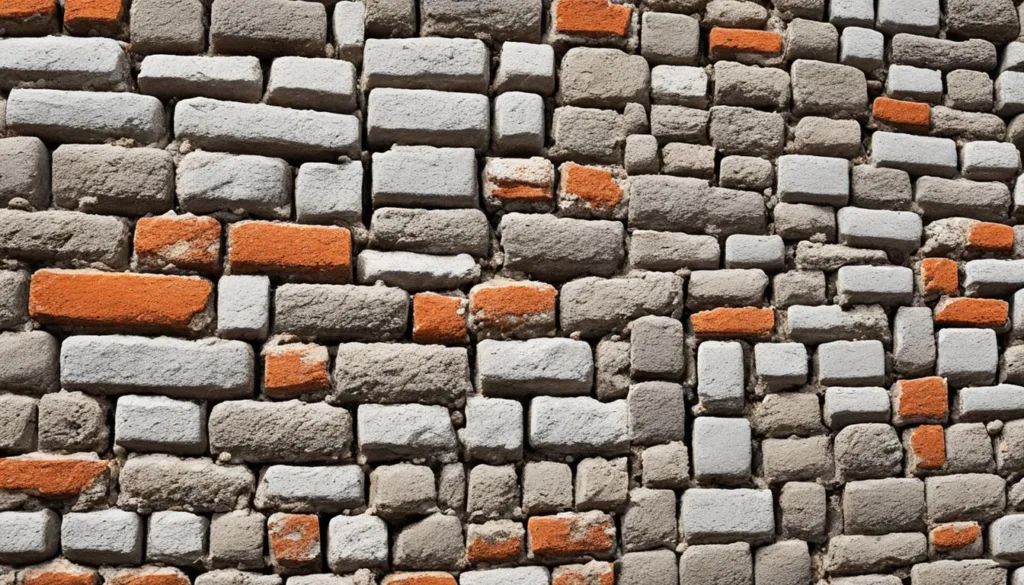

Grout is an essential component of tile installation and requires careful preparation and application to ensure its effectiveness. Its primary function is to fill the gaps between tiles, maintain alignment, and provide a seamless appearance.
Key Differences Between Mortar and Concrete
Mortar and concrete are both indispensable building materials, but they have distinct differences that make them suitable for different applications. Here are five key differences between mortar and concrete:
| Mortar | Concrete | |
|---|---|---|
| Composition | Made of cement, sand, and water | Made of cement, sand, water, and coarse aggregates (like gravel) |
| Strength | Lower strength than concrete | Higher strength than mortar |
| Texture | Smaller particle size and smoother texture than concrete | Rougher texture than mortar due to the presence of aggregates |
| Application | Used for binding brick, stone, and other masonry units together | Used for larger scale projects like road work, building foundations, and structural walls or beams |
| Maintenance | Less maintenance is needed as it is less prone to cracking | High maintenance is needed as it is prone to cracking |


As shown in the table above, the composition, strength, texture, application, and maintenance requirements of mortar and concrete differ. Therefore, it is important to consider the requirements of a project before choosing between the two materials.
Key Differences Between Mortar and Grout
Mortar and grout are both used in construction, but they have different compositions and purposes. Here are the five key differences between mortar and grout:
- Composition: Mortar is a mixture of sand, cement, and water, while grout is made from cement, water, and fine sand or gravel.
- Purpose: Mortar is used to join bricks, blocks, and stones together, while grout is used to fill gaps between tiles or reinforce masonry.
- Application: Mortar is applied using a trowel, while grout is typically applied with a rubber float or a grout bag.
- Texture: Mortar has a thicker, more spreadable texture, while grout is thinner and more fluid.
- Curing Time: Mortar typically takes longer to set and cure, while grout can be cured in just a few days.
Understanding the differences between mortar and grout is important for any construction project. While they may seem similar, their distinct properties make them ideal for specific applications.


Key Differences Between Cement and Mortar
While it’s easy to use the terms “cement” and “mortar” interchangeably, there are some significant differences between the two.
| Cement | Mortar |
|---|---|
| Cement is a binding agent made from a mixture of limestone, clay, and other minerals that have been kiln-fired to remove any moisture and volatile organic compounds. | Mortar is a mixture of cement, sand, and water that is used to hold bricks or other building materials together. |
| Cement is harder and stronger than mortar. | Mortar is less rigid and allows for more flexibility, making it ideal for filling gaps between bricks. |
| Cement is primarily used to make concrete, which is used for construction projects such as buildings, bridges, and roads. | Mortar is primarily used in masonry projects such as stone walls, brick walls, and chimneys. |
| Cement is more expensive than mortar. | Mortar is relatively inexpensive and easy to mix. |
| While cement takes longer to dry and sets slower than mortar, it is stronger and more durable in the long run. | Mortar sets faster and is more forgiving when mistakes are made during construction. |
It’s important to understand the differences between cement and mortar when choosing which material to use for your construction project. Cement is ideal for creating strong, long-lasting structures, while mortar is better suited for masonry projects that require flexibility.
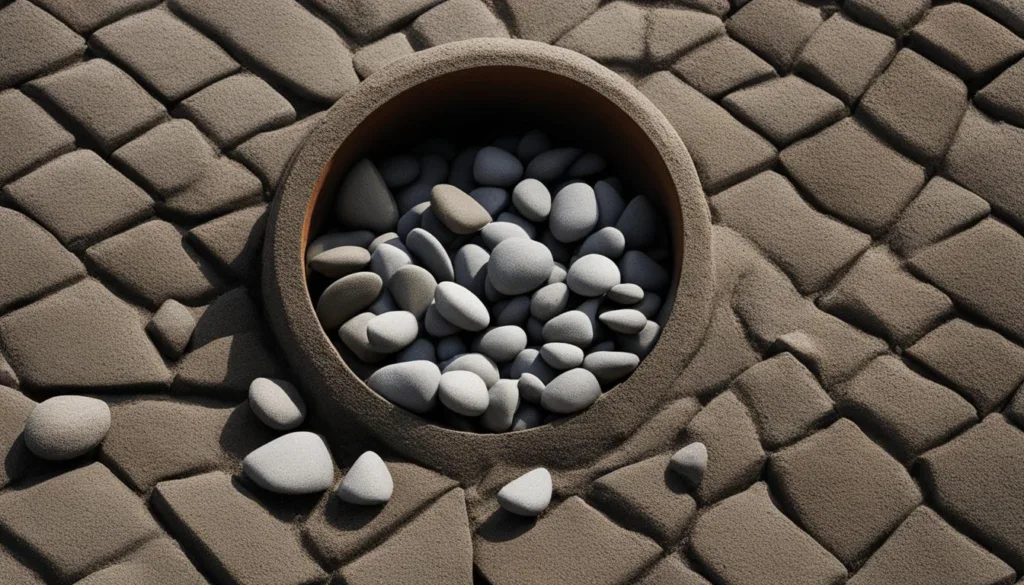

Comparing Mortar, Concrete, and Grout
When it comes to construction, choosing the right building material can make all the difference. Mortar, concrete, and grout are all common materials used in construction projects, each with their distinct properties and advantages.
Mortar vs Concrete vs Grout: What’s the Difference?
Mortar is a mixture of cement, sand, and water which is used to bond bricks or other materials together. Concrete, on the other hand, is made up of cement, sand, gravel, and water and is used to create sturdy foundations, walls, and structural elements. Grout is similar to mortar, but contains smaller particles and is used to fill in gaps between tiles, bricks, or other materials.
Unique Attributes and Applications
The specific attributes of mortar, concrete, and grout make them well-suited for different construction applications. Mortar, for example, is traditionally used in masonry projects due to its bonding properties and ability to withstand high compressive forces. Concrete, on the other hand, is ideal for use in foundations and other structural elements due to its strength and durability.
Grout, meanwhile, is frequently used in tiling projects to fill the gaps between tiles and prevent moisture from seeping in. It’s also used in other construction projects such as reinforcing walls and filling voids in concrete blocks.
Visual Comparison Table
| Material | Composition | Primary Use |
|---|---|---|
| Mortar | A mixture of cement, sand, and water | Bonding bricks or other materials together in masonry projects |
| Concrete | A mixture of cement, sand, gravel, and water | Creating foundations, walls, and structural elements |
| Grout | A mixture of cement, sand, and water with smaller particles than mortar | Filling gaps between tiles, reinforcing walls, filling voids in concrete blocks |
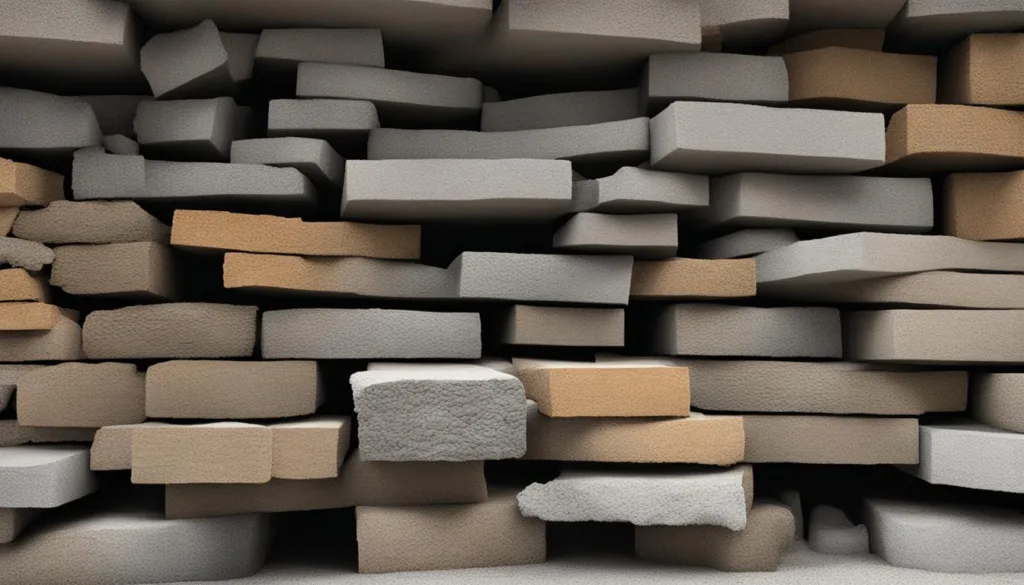

Overall, choosing between mortar, concrete, and grout comes down to the specific requirements of your construction project. By understanding the unique attributes and applications of each material, you can make informed decisions that will help you achieve the desired results.
Applications of Mortar, Concrete, and Grout
Understanding the specific uses of mortar, concrete, and grout is essential for determining which is most suitable for a given construction project. Here are some common applications for each:
| Mortar | Concrete | Grout |
|---|---|---|
| Masonry: Used to bind brick, stone, and other materials | Foundations: Forms a strong base for structures | Tile installation: Fills gaps between tiles |
| Plastering: Applied as a smooth finish to walls and ceilings | Driveways and sidewalks: Provides a durable surface for foot and vehicle traffic | Reinforcement: Strengthens the integrity of masonry walls by filling cavities |
| Fireplace construction: Resistant to high temperatures | Retaining walls: Holds back soil and prevents erosion | Machinery Support: Provides a solid base for heavy equipment |
While these are the most common uses, mortar, concrete, and grout have many other applications, depending on the specific project requirements. It is important to consult with a professional to ensure the correct material is used for a successful and safe construction project.
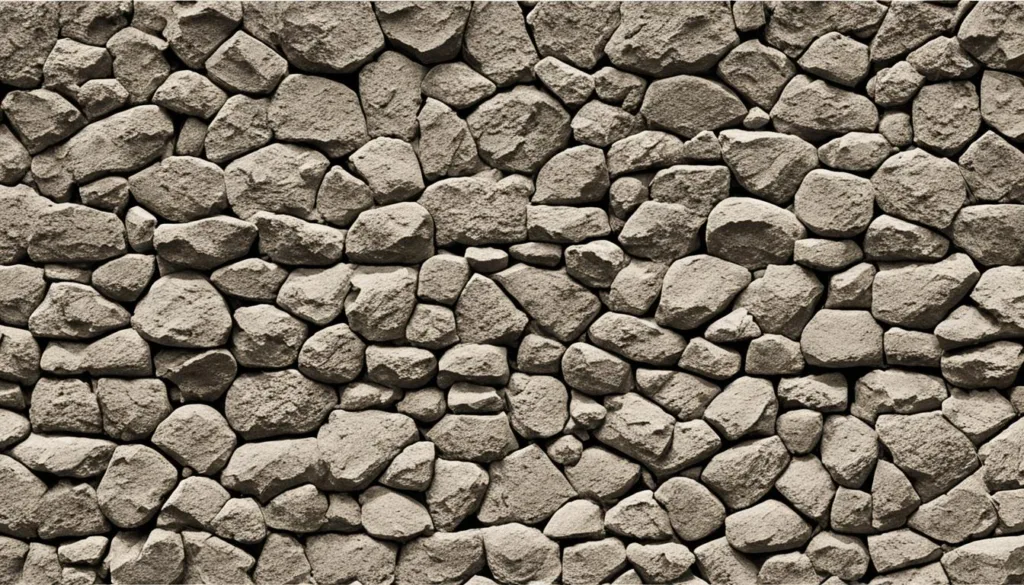

Factors to Consider When Choosing
When it comes to choosing between mortar and concrete, certain factors should be taken into consideration to ensure that the right material is selected for a particular project. Below are some of the key factors that should guide the decision-making process:
- Project Requirements: The nature of the project and the specific requirements will play a critical role in determining which material is best suited for the job. For instance, if a project requires high compressive strength, then concrete would be the preferable choice. On the other hand, if the goal is to join masonry units, then mortar would be more appropriate.
- Environment: The environmental conditions of the project site should also be considered, including temperature, moisture, and exposure to different elements. Concrete may be prone to cracking or spalling in harsh winter conditions, while mortar can deteriorate in wet environments.
- Desired Outcome: What the project owner hopes to achieve will guide the choice between mortar and concrete. If the goal is to create a smooth finish, then mortar would be a better choice, while concrete would be best suited for structural work.
- Cost: The cost of materials and labor will also be a factor. In general, mortar is less expensive than concrete, but this may vary depending on the specific project and location.
By considering these factors and others that may be specific to a particular project, contractors and builders can make an informed decision about whether to use mortar or concrete.
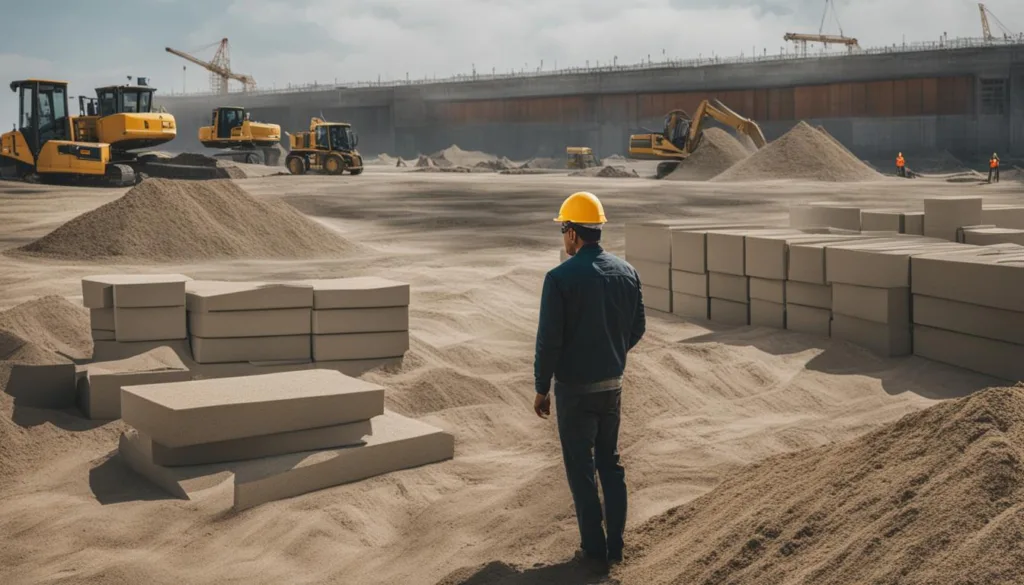

Strength and Durability Comparison
When it comes to construction projects, choosing the right materials for the job is essential. In considering the strength and durability of mortar versus concrete, there are some key differences to keep in mind.
Concrete is known for its strength, with a compressive strength of 3000-7000 psi (pounds per square inch) while the compressive strength of mortar typically falls between 1500 and 2500 psi. However, it is important to note that the strength of concrete can vary depending on the mix design and curing process, as well as the quality of the ingredients used.
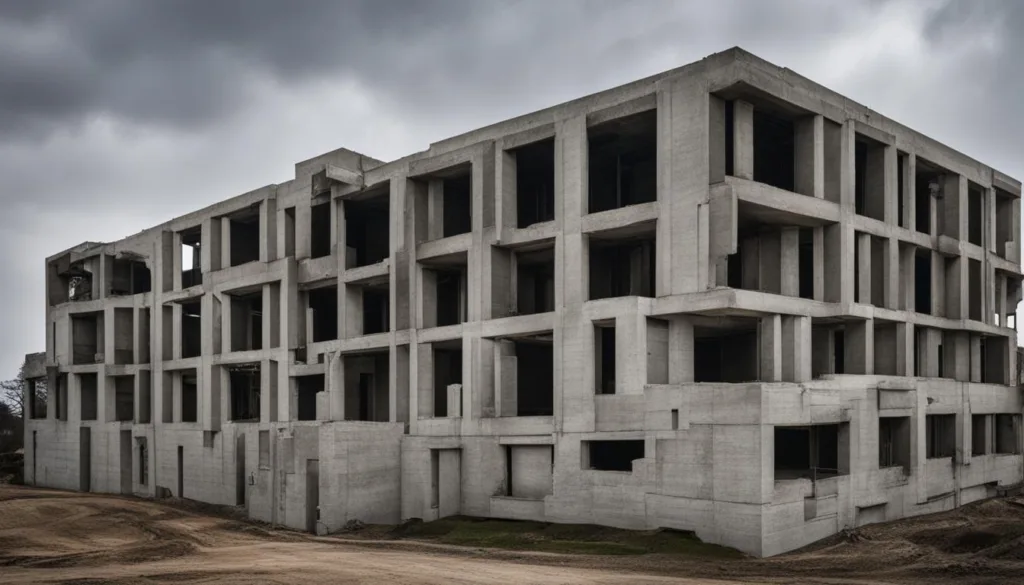

While concrete may be stronger, mortar offers benefits in terms of durability. Mortar is more resistant to moisture damage and can withstand extreme temperatures better than concrete. It is also less prone to cracking, particularly in areas with seismic activity or ground movement.
When choosing between mortar and concrete, it is important to consider the specific requirements of the project and the environment in which it will exist. While concrete may provide greater strength, mortar may be a better option for projects where durability is a primary concern. Ultimately, the choice will depend on the specific needs and parameters of the project at hand.
Cost and Maintenance Considerations
When considering whether to use mortar or concrete for a construction project, it’s important to take into account both the initial cost and the maintenance requirements. While concrete generally has a higher upfront cost than mortar due to its greater strength and durability, it may eventually prove to be the more cost-effective option in the long run.
Maintenance is also a factor to consider when choosing between mortar and concrete. Mortar tends to require more frequent repair and upkeep due to its lower strength, while concrete is generally more durable and requires less maintenance.
Ultimately, the decision to use mortar or concrete will depend on the specific needs of the project, as well as the available budget and resources for maintenance and upkeep.
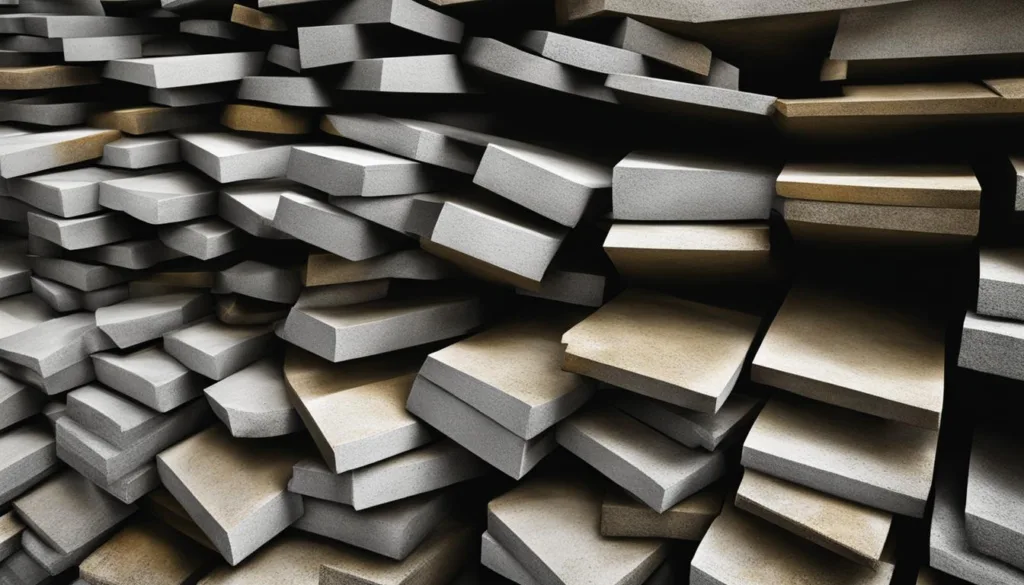

Conclusion
Overall, it is clear that mortar and concrete are two distinct building materials with unique properties and uses. Mortar, a mixture of cement, sand, and water, is typically used to bond bricks and stones together, while concrete, made from cement, water, and aggregates, is commonly used for sidewalks, building foundations, and other structural applications.
Grout, on the other hand, is a type of cement-based material that serves as a joint filler between tiles or stones. While it shares some similarities with mortar, it is generally less strong and more porous.
When choosing between mortar and concrete, there are several factors to consider, such as project requirements, environment, and desired outcomes. Mortar is typically more affordable than concrete, but concrete is generally stronger and more durable.
In summary, both mortar and concrete are essential building materials that contribute to the construction of buildings and structures. By understanding the key differences between these materials, one can make informed decisions about which material to use for a given project.
Thank you for reading this article on the differences between mortar and concrete. We hope it has been informative and helpful in your decision-making process.
FAQ
Q: What is cement?
A: Cement is a binding material used in construction that hardens and adheres to other materials to form a solid structure. It is made by combining limestone, clay, and other minerals, and then heating the mixture at high temperatures.
Q: How is cement made?
A: Cement is made by crushing and grinding limestone, clay, and other minerals, then heating them in a kiln at high temperatures. The resulting powder, known as clinker, is mixed with gypsum to form the final cement product.
Q: What is concrete?
A: Concrete is a composite material made up of cement, sand, gravel, and water. It is used in construction to create strong and durable structures such as buildings, bridges, and roads.
Q: How is concrete made?
A: Concrete is made by mixing cement, sand, gravel, and water in specific proportions. The mixture is then poured into molds or formwork and allowed to harden, resulting in a solid structure.
Q: What is mortar?
A: Mortar is a type of paste used in masonry construction to bind bricks, stones, or other materials together. It is made by mixing cement, sand, and water to form a thick consistency.
Q: How is mortar made?
A: Mortar is made by combining cement, sand, and water in specific ratios. The mixture is then mixed thoroughly to achieve a uniform consistency suitable for binding masonry materials.
Q: What is grout?
A: Grout is a fluid mixture used to fill gaps between tiles, stones, or other materials in construction projects. It usually consists of cement, sand, and water, and can also contain additives for enhanced performance.
Q: How is grout made?
A: Grout is made by mixing cement, sand, water, and sometimes additives to achieve the desired consistency. The mixture is then applied to the gaps between tiles or stones and allowed to harden.
Q: What are the key differences between mortar and concrete?
A: The key differences between mortar and concrete are: 1. Composition: Concrete contains coarse aggregates such as gravel or crushed stone, while mortar does not. 2. Strength: Concrete is stronger than mortar and can bear heavier loads. 3. Application: Concrete is used for structural purposes, such as foundations and walls, while mortar is primarily used for masonry work. 4. Consistency: Concrete has a thicker consistency than mortar. 5. Durability: Concrete is more resistant to weathering and can withstand harsh conditions better than mortar.
Q: What are the key differences between mortar and grout?
A: The key differences between mortar and grout are: 1. Purpose: Mortar is used to bind masonry materials together, while grout is used to fill gaps between tiles or stones. 2. Consistency: Mortar has a thicker consistency, while grout is more fluid. 3. Strength: Mortar is generally stronger than grout due to the higher cement content. 4. Application: Mortar is used in construction, while grout is commonly used in tiling projects. 5. Coloring: Grout often contains pigments to match or enhance the color of tiles, while mortar is typically gray.
Q: What are the key differences between cement and mortar?
A: The key differences between cement and mortar are: 1. Composition: Cement is the main ingredient in mortar, along with sand and water. 2. Application: Cement is used as a binder in various construction materials, while mortar is specifically used for masonry work. 3. Strength: Cement is stronger than mortar and can withstand higher loads. 4. Consistency: Cement is a fine powder, while mortar has a paste-like consistency. 5. Usage: Cement is used to create concrete, mortars, and other construction materials, while mortar is used to bind bricks, stones, or other materials together.
Q: What are the differences between mortar, concrete, and grout?
A: Mortar, concrete, and grout have the following differences: 1. Composition: Mortar consists of cement, sand, and water; concrete includes cement, sand, gravel, and water; grout typically contains cement, sand, water, and additives. 2. Purpose: Mortar is used for binding masonry materials, concrete is used for structural purposes, and grout fills gaps in construction projects. 3. Consistency: Mortar has a thick consistency, concrete has a medium consistency, and grout has a more fluid consistency. 4. Application: Mortar is used in bricklaying and stone masonry, concrete is used for building foundations and structures, and grout is used for tiling and filling gaps. 5. Strength: Concrete is the strongest, followed by mortar, and then grout.
Thanks For the Great Attention!
Good Bye & Take Care
Happy Learning
Also, Read,
1000sqft House Plinth Beam Cost

